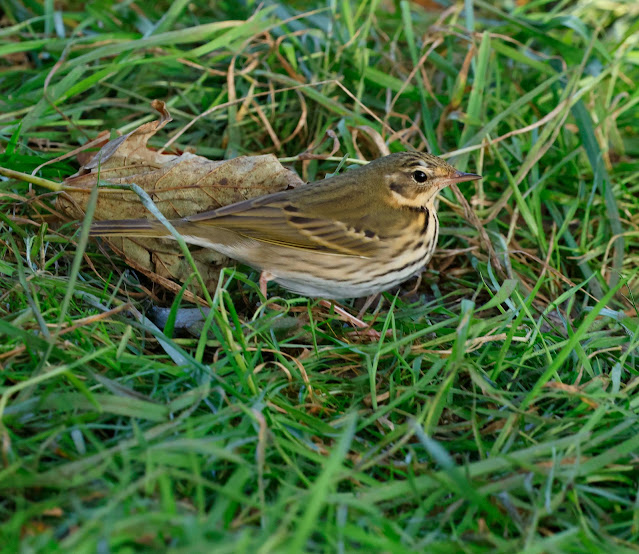On the way back from visiting the Siberian Stonechat at Hamnavoe we made a small diversion to view an Olive backed Pipit (OBP) that had been discovered creeping around inside a walled garden at Voxter. It was mid afternoon on a grey and showery day as we entered through the metal gate that granted access to the garden and joined about a half dozen other birders already crammed into a corner under the trees by the gate.
The pipit was just about visible on the opposite side of the garden, wending its way under fallen tree branches and through the unmown grass and dead leaves but the viewing was very restricted as it could only be seen from one point in the garden, by the gate.
Nevertheless we persisted while enduring heavy rain squalls and we saw the pipit reasonably well although it consistently remained on the far side of the garden, creeping along under the wall, its olive brown upperparts rendering it superbly camouflaged in the gloom below the trees, the browns of fallen leaves and bare patches of earth rendering it at times nigh on indiscernible.
Unfortunately one person decided he needed to get closer with the result the pipit flew up into the trees and after waiting some time with no sign of the pipit returning to the ground we left for home.
We discussed the situation regarding the pipit back at our rented house in Scalloway and determined to make another visit to Voxter the next day, leaving it late in the hope the garden would be less popular with birders.It was just as well we left it until the afternoon as heavy rain and strong winds lashed the land before abruptly ceasing and then out came the sun!
We approached the walled garden in mid afternoon not without some trepidation, hoping there would be no one there and to our immense relief we had it to ourselves.We often follow this general approach if we wish to photograph a bird as we consistently find that the less people there are present the more our target bird will show itself.
Initially the three of us stood in the same corner of the garden under the trees but there was no sign of the OBP in the places we had seen it yesterday. I caught sight of a slight movement in a large sycamore near to us in the centre of the garden and got a brief view of the pipit running along a branch but then it was gone. I alerted the others with a stage whisper and another movement in the same tree raised our hopes but this time it was a male Blackcap examining the leaves.
Then suddenly, like an apparition, there was the pipit on the ground literally a few metres away. Where had it materialised from? Presumably it had dropped from the tree unnoticed. Incredulity, delight, a whole range of emotions consumed me as I regarded it wandering around seemingly uncaring about our close proximity.
We stood absolutely still and the pipit wended its uncertain passage through the grass straight towards us.We could not believe it as it passed within feet of us, its tail slowly pumping up and down.
For a good half an hour we watched and photographed the pipit as it deliberately and slowly walked around feeding under the sycamores that shrouded the garden. No one else came to break the spell. The wind rose slightly, always a sign of rain coming, and soon heavy rain was falling on the garden and us.We stood under a large sycamore which afforded some shelter but the rain still spattered on our hoods.The OBP obviously felt the same about the weather and walked to within a few metres of us to stand under a bush out of the rain. A charmingly unique experience.
A picture of contentment the pipit stood quiet and still, fluffing out its breast feathers and casually looking around.For fifteen minutes the rain fell and the pipit never moved from its shelter.Slowly the rain ceased, the pipit became more active and then re-commenced its perambulations around the garden.
A Great Spotted Woodpecker, large, boldly marked black and white landed heavily to inspect a tree branch just above the pipit. Such a contrast between the two, the pipit small, demure, understated in plumage, the woodpecker bulky, brash and colourful.
Olive backed Pipits when seen close are beautifully marked birds.I suppose you could call them a birder's bird with a face that is strongly marked with cream and black lines and upperparts that are plain brown with a distinct olive green tinge.The whiter underparts, especially the breast and flanks, are profusely streaked with black and they have noticeably pink legs and feet. Put all this together and it adds up to a pleasing, understated vision of loveliness.
Despite their delicate appearance and only being found breeding in Europe in the northern Urals they are an annual vagrant to Britain, mainly in October and records are on the increase. They are widespread breeding birds from central and eastern Siberia to northern China and Japan and migrate to winter in southern China and Taiwan as well as northern and central parts of southeast Asia.
Two birders entered the garden and we pointed out the pipit to them but with their arrival, for us the spell had been broken.
The OBP continued its wanderings, picking minute prey from the blades of grass.It found a large moth but after shaking and failing to swallow the moth, it was discarded for smaller prey.
Silently we signalled to each other we should go as it could get no better than this.












No comments:
Post a Comment